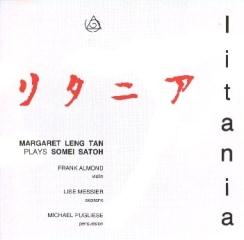Margaret Leng Tan Plays Somei Satoh – Litania (1988)
Margaret Leng Tan Plays Somei Satoh – Litania (1988)

1 The Heavenly Spheres Are Illuminated By Lights 11:45 Lise Messier – soprano Margaret Leng Tan - piano Michael Pugliese - Percussion 2 Birds In Warped Time II 11:03 Frank Almond - Violin Margaret Leng Tan – piano 3 Incarnation II 18:15 Margaret Leng Tan - piano with digital delay 4 A Gate Into The Stars 8:13 Margaret Leng Tan – solo piano 5 Litania 13:06 Margaret Leng Tan – two pianos with digital delay
The music of Satoh is atmospheric and easy-listening. It is tonal, often sweet and at times saccharine even, and based on simple harmonies and harmonic progressions. The liner notes (by pianist Margaret Leng Tan herself) compare "The Heavenly Sphreres are Illuminated By Lights" (1979), with its wordless and sinuous melismatas, to the famous coloratura aria in Villa Lobos' 5th Bachianas Brasileira, and they are right: it is Villa Lobos in the New Age era. But, as simplistic and going-for-effect immediate effect as it does, it is, well, effective and does elicit a certain entrancement.
I liked very much the minimalism applied to folk music that pervades "Birds in Warped Time II" for Violin and Piano from 1980. You get again a long and sinuous melody on the fiddle, with many glissandos and wide vibrato, seeming straight out of some far away Japanese countryside, over a continuous, shimmering piano ostinato straight out of Glass or Ten Holt. But around the 5 minute mark the violin melody moves to more chromatic glissandos and somber moods very much evocative of Enescu's 3rd Violin and Piano Sonata or Impressions d'Enfance, I find. But it is the kind of piece whose atmosphere, I feel, would gain from being developed over the time span of an hour or more, in a Morton Feldman fashion. Here, its 11 minutes are almost too short.
In "Incarnation II" for Piano solo from 1982 and Litania for Two pianos from 1973 (both "with digital delay", whatever that - unexplained by the liner notes - may be), Satoh appears as an heir to Cowell in such atmospheric pieces as the Three Irish Legends ("The Tides of Manaunaun", "The Hero Sun","Voice of Lear"). Although, unlike the American composer, Satoh is content to stick with the time-honored approach of striking the keys individually (rather than depressing them in clusters or directly strumming or plucking the strings), his music is, like Cowell's, motioned by a slow-moving ebb and flow of continuous sound evocative of the deep rumble of the universe. For "Incarnation", think of the opening of Rheingold for minimalist piano, and you won't be too far. "Litania" is even more impressive because it is constantly louder and angrier. It is the music Kubrik could have used in 2001 when astronaut David Bowman is hurled into the other dimension (but he used Ligeti's Lux Aeterna for that). It could be music to accompany the telluric upheavals that caused the disappearance of the dinosaurs (and Walt Disney used Stravinsky's Rite of Spring for that). Leng Tan maintains that the piece's "penchant for sonic violence" "invites comparisons to the Polish avant-garde composer Krzystof Pendrerecki's "Threnody for the Victims of Hiroshima", and I agree, although Penderecki's harmonic progressions are more complex. In the fast vibrations of repeated notes, Ligeti's Continuum for harpsichord also came to mind. Anyway, these to pieces may not be extremely elaborate, but ultimately highly atmospheric and fascinating.
I have another version of Incarnation II by Joanna MacGregor (Play, see my review), although it is not entirely clear if it is the same. Leng Tan mentions that it "is presented here in an updated, extended performance of the original 1977 composition". It also here has a duration of 18:15 minutes, against 7 for Mac Gregor, although this may have to do with how many repeats of each section both pianists apply (hard to tell without a score and with music that "moves on" so slowly and imperceptibly). Interpretively, MacGregor is more powerful, but Leng Tan's vibration (the piece is a long tremolo with slow harmonic progressions) is faster. Both approaches work for me, but given the atmospheric nature of the piece, length and the sense of time slowly unfolding are a preferable option.
The contrast couldn't be greater with "A Gate into the Stars" for solo piano from 1982. Here, the textures are sparse, one note here, one note there, a simple, wistful melody, the kind of thing you'd think was improvised in the middle of the night in an silent Buddhist cloister (are there Buddhist cloisters ?). Music to put you gently to sleep, really. Play it to your babe and see if it works. Very pretty.
For the better or - and - the worse, it is the term "pretty" that most often came to my mind while listening to this disc - not with Litania, though. There, it was "impressive".
The liner notes claim that this New Albion release, from 1988, was the first recording in the West of the music of Somei Satoh. The artists participated in the premiere performances of Satoh's music in the US in 1984 and 1985. My only regret is that this is not the complete piano music of Satoh: the liner notes mention "Hymn for the Sun" (1973) and "Cosmic Womb" (1977) (the latter, Leng Tan plays on Margaret Leng Tan: Sonic Encounters: The New Piano - Works of John Cage / Alan Hovhaness / George Crumb / Somei Satoh / Ge Gan-Ru. The CD is 63 minutes long, which is more than acceptable, but more could have fit. --- Discophage, amazon.com
download (mp3 @320 kbs):
yandex 4shared mega mediafire zalivalka cloudmailru uplea








